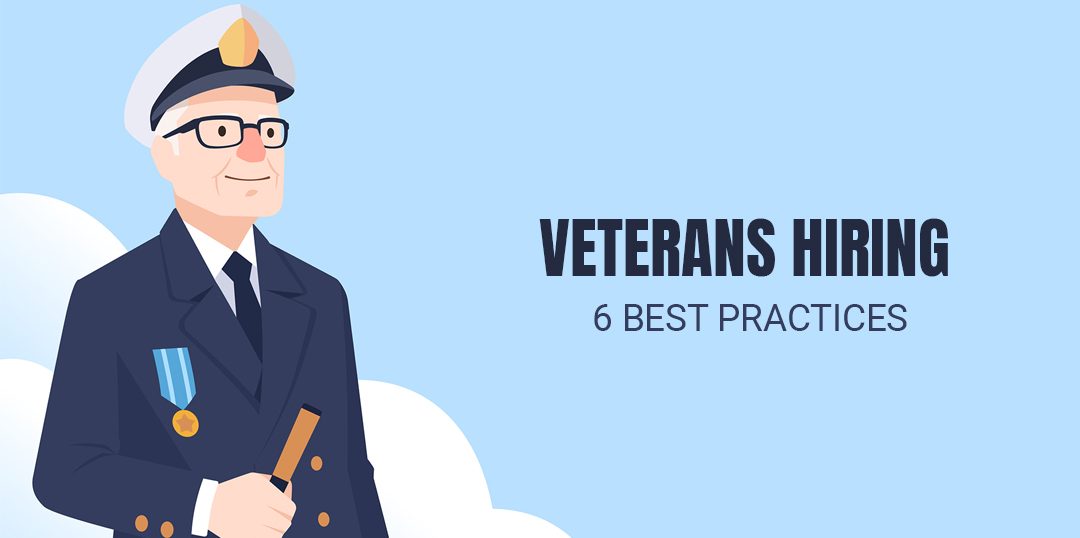6 Best Practices to Follow While Hiring Veterans
A few years back, McCollum – a military veteran – began her job as a senior consultant in the advisory services practice at EY in New York City. She was hired without any prior experience on a similar profile. Moreover, there was no correlation between her role in military intelligence and her job at EY. Instead, she was making use of a lot of other things she learned in the military including writing, giving presentations, and problem-solving.
“My job is so unpredictable. Being a consultant, there’s no playbook. The clients have different needs every week. Adaptability is huge,” she says. “The military was very much like that—you never knew what to expect. Things would change on [a] dime. So learning to have that flexibility, to react to change, and to quickly come up with a plan is a valuable skill here.”
This is just an example of how veterans use their military learnings in their corporate jobs. There’s a lot more that veterans bring to the table when they join a corporate setup. Every year approximately 200,000 men and women leave U.S. military service and return to life as civilians. This means every year a new wave of veterans enter into the marketplace looking for employers like you who can tap on their military learned skills and provide them new means of living.
Based on our veteran hiring experience we bring you six veteran hiring practices that will help you approach these veterans with the right psyche and skill.
- Commit to Veteran Hiring
- Build Civilian Transition Training Programs
- Create a Dedicated Veteran Hiring Page
- Utilize Social Media to Expand Reach
- Provide Hiring Opportunities to Military Spouses
- Communicate Clearly and Empathetically
1. Commit to Veteran Hiring
If you are hiring veterans for the sake of meeting your workplace diversity goals then you are starting off on the wrong foot. You must be committed to veteran hiring to holistically help veterans transition into the corporate space. For that, firstly be clear about why hiring veterans is important and what value they bring to your organization – leadership, skill, discipline, management, and more.
Secondly, strategize the job roles that could utilize the military experience and look for veterans accordingly. However, at the same time, ensure that no biases hinder your decision-making process. Veterans will not come with the same skills that your industry, job, or company demands. But with the right training, guidance, and skills, they can be as valuable as any other professional in your field.
![]()
Read More: 5 Skills Veterans Bring to the Workplace
2. Build Civilian Transition Training Programs
For veterans, transitioning from military to civilian life is not easy. Their methods and discipline of doing everyday tasks differ from that of civilians. This is why you must give veterans appropriate time and training to understand non-military norms and changes so that when they start working with other civilian teammates, there are no conflicts or issues.
To do so, build programs that present the realities of transitioning to civilian life and offer resources that provide required emotional, employment, and financial support. These programs help veterans and their families smoothly transition into civilian life without alienation.
There are civilian transition programs already in place such as Transition Assistance Program (TAP), that work to provide information and training to ensure service members transitioning from active-duty are prepared for their next step in life – whether pursuing additional education, finding a job in the public or private sector, or starting their own business. You can partner with these programs and get your veteran hires enrolled for civilian training.
3. Create a Dedicate Veteran Hiring Career Page/Site
Build a dedicated landing page to showcase your complete veteran hiring program. A separate page demonstrates your commitment to veteran hiring and gives special attention to veterans’ concerns. Also, it gives you a platform to directly talk to veterans and address their concerns.
Besides, you can use this page to show what benefits, facilities, and training you provide to veterans. Further, you can present stories of already employed veterans in your organization to build trust. Listening to stories from people similar to them would give veterans the required confidence and boost.
Organizations like IBM, Accenture, and Google are already following this practice to give due attention to veterans and veteran hiring programs.
![]()
4. Utilize Social Media Platforms to Widen Reach
This is no news that social media’s reach is unmatched. The same holds true in the case of veteran hiring as well. While hiring veterans, you can use social media as a key hiring tool to connect with veterans. Run social media job ads, show job posting in veteran hiring groups, or share the job posts in a network, there are plenty of ways through which you can multiply your veteran outreach.
Also, you can use social media to help your veteran hires connect with other veteran hires. This network-building instills confidence in veterans and helps you understand and address veteran challenges.
![]()
5. Provide Hiring Opportunities to Military Spouses
It’s an overlooked talent pool that repeatedly gets neglected by the organizations. According to a study by the U.S. Chamber of Commerce Foundation, the unemployment rate for military spouses has hovered around 20 to 25 percent over the last decade.
Military spouses put a lot on the line when they are relocating with their husbands/wives. Prominent among all is their opportunity to work. Therefore, it’s a good practice to provide military spouses with a fair opportunity for the job.
By offering jobs to military veterans as well as their spouses you increase the chances of hiring and retaining quality veteran employees for a long time. Also, it shows your seriousness and wholesome attitude towards veteran hire which gives you an edge over other veteran hiring organizations. You can partner with the Military Spouse Employment Partnership Program by the U.S Department of Defense, to connect with similar organizations and military spouses in search of work.
6. Communicate Clearly and Empathically
This is crucial in veteran hiring. As veterans are new to the civilian lifestyle, you must ensure to not make any assumptions while evaluating their fitness for the job. Be clear with job descriptions, responsibilities, questions, and your concerns. At the same time, infuse empathy in your communication. There may be occasions when few civilian jargon may confuse military veterans during the communication. Therefore to be as clear as possible to avoid any communication loopholes.
Also, since veterans are new to the civilian setup, you must give the benefit of doubt to their resumes building, communication, or other professional skills that can be taught. Also, do not be blunt and quick with your judgment. Be empathetic while interviewing, judging, or evaluating them.
![]()
Subscribe For Updates
Categories
- Accountant
- AI
- Automation
- Awards and Recognitions
- Blue Collar Staffing
- Burnouts
- Campus Recruiting
- Cloud
- Co-Ops agreements
- Company Culture
- Compliance
- contingent workforce
- Contingent Workforce
- COVID-19
- Cyber Security Staffing
- Data Strategy
- Digital Transformation
- direct sourcing
- Distributed Workforce
- Diversity
- Diversity & Inclusion
- Economy
- Events & Conferences
- fleet industry
- Gig Economy
- Girls in Tech
- Global Talent Research and Staffing
- Government
- Healthcare
- Healthcare Staffing
- Hiring Process
- Hiring Trends
- Home Helathcare
- HR
- HR Practices
- HR Tech
- IT
- Labor Shortages
- Life Science
- Local Governments
- News
- Nursing
- Payroll Staffing
- Public Sectors
- Recruiting
- Remote Work
- Skill Gap
- SMB Hiring
- Snowflake
- Staffing
- Staffing Augmentation
- Staffing Challenges
- Talent ROI
- Tech Staffing
- Technology
- Tips & tricks
- Total Talent Management
- UI/UX Design
- Uncategorized
- Veteran Staffing
- Veterans Hiring
- Veterans Hiring
- Workforce Management
Recent Posts
- Automation in Recruiting: From Chatbots to Predictive Screening
- Gig Economy Expansion: The Impact on Talent Pools and Business Models
- Skills-Based Hiring: Why Credentials Alone Don’t Cut It in 2025
- Procurement 3.0: AI & Intelligent Automation in 2025
- Q3 Is Here: Is Your Contingent Workforce Strategy Falling Behind?
Newsletter
Archive
- September 2025
- August 2025
- June 2025
- April 2025
- March 2025
- December 2024
- November 2024
- October 2024
- September 2024
- August 2024
- July 2024
- June 2024
- May 2024
- April 2024
- March 2024
- February 2024
- January 2024
- December 2023
- November 2023
- October 2023
- September 2023
- August 2023
- July 2023
- June 2023
- May 2023
- April 2023
- March 2023
- February 2023
- December 2022
- November 2022
- October 2022
- September 2022
- August 2022
- July 2022
- June 2022
- November 2021
- October 2021
- September 2021
- August 2021
- July 2021
- June 2021
- May 2021
- April 2021
- March 2021
- February 2021
- January 2021
- December 2020
- November 2020
- October 2020
- September 2020
- August 2020
- July 2020
- June 2020
- May 2020
- April 2020
- March 2020
- February 2020
- January 2020
- December 2019
- November 2019
- October 2019
- September 2019
- August 2019
- July 2019
- June 2019
- May 2019
- January 2019
- December 2018
- November 2018
- October 2018
- September 2018
- August 2018
- July 2018
- June 2018
- May 2018
- April 2018
- March 2018
- February 2018
- January 2018
- December 2017
- November 2017
- October 2017
- September 2017
- August 2017
- July 2017
- June 2017
- May 2017
- November 2016
- October 2016



